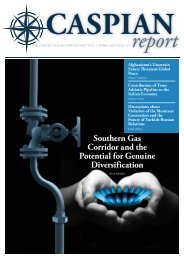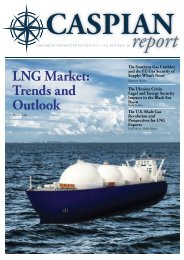Hazar Raporu - Issue 02 - Winter 2012
Create successful ePaper yourself
Turn your PDF publications into a flip-book with our unique Google optimized e-Paper software.
land-based traffic through Azerbaijani<br />
territory. Moreover, the new state-of-theart<br />
Baku International Sea Trade Port and<br />
Logistics Center at Alyat and the new<br />
Baku Heydar Aliyev International Airport<br />
will both have a central place in the<br />
vision of Azerbaijan as a global transport<br />
hub. Last, but not least, the government<br />
plans to establish Free Economic Zones<br />
(FEZs) and invest more than $60 billion<br />
in real estate projects in and around<br />
Baku, essentially aiming to transform the<br />
national capital into the “Dubai of the<br />
Caspian.”<br />
These projects will genuinely strengthen<br />
Azerbaijan’s position in the region and<br />
enable it to become a magnet for land- and<br />
air-based trade between and among the<br />
states of Europe and Asia. Baku will act<br />
as a gateway to Central Asia for Europe<br />
and a door to Europe for Central Asia and<br />
China. It has the potential to become a<br />
“hub of hubs” on the Caspian Sea, but this<br />
will require articulation of a clear vision<br />
today for the Azerbaijan of 2030.<br />
The Need for an Integrated<br />
Development Strategy<br />
Close examination of the ongoing and<br />
planned infrastructure and transportation<br />
projects in the region, including<br />
Azerbaijan, would reveal a lack of<br />
coherence in the development strategy for<br />
the non-oil economy. Important and useful<br />
projects are being planned and initiated<br />
independently of one another, without<br />
the necessary cross-sector and intrasector<br />
coordination. In other words, these<br />
projects do not seem to be guided by a<br />
unified objective. Unless a clear, integrated<br />
“big picture” strategy is set forth today, the<br />
development trajectory of Azerbaijan, or<br />
of any other country in the region, for that<br />
matter, is likely to be halting and subject to<br />
chance. This is not to say that Azerbaijan<br />
could not achieve high per capita income<br />
or social-welfare advancement without<br />
such a vision. The “trial and error”<br />
approach certainly offers one type of<br />
problem-solving strategy. But in addition<br />
to being risky, such an approach would<br />
consume far more in terms of resources,<br />
time, and energy in the long run, and its<br />
success would not be guaranteed.<br />
The report you are about to read has been<br />
written in the hope of contributing to<br />
the vision of the future of Azerbaijan and<br />
the Caspian region. It focuses on Euro-<br />
Asian trade, transportation and logistics,<br />
FEZ, and port development, and draws<br />
some lessons for Azerbaijan and other<br />
countries in Central Eurasia aspiring to<br />
become regional commercial hubs and<br />
take advantage of the growing regional<br />
as well as continental trade between two<br />
major economic blocs, namely Europe and<br />
Asia. In particular, it proposes a specific<br />
development scheme for Azerbaijan’s hub<br />
strategy. As is noted throughout the report,<br />
the opportunities for Azerbaijan are many,<br />
and the realization of this potential will<br />
benefit the whole region, not just a single<br />
state. This means that for Azerbaijan to<br />
achieve its national objectives, it needs<br />
to coordinate its efforts with those of<br />
neighboring countries in the region.<br />
CASPIAN REPORT<br />
109 107










